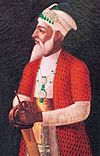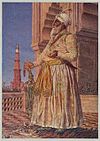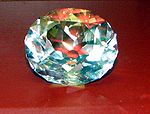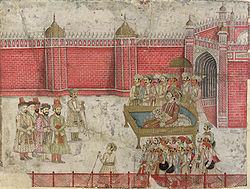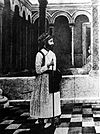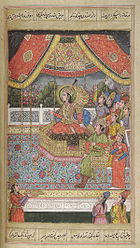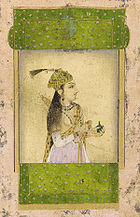- Muhammad Shah
-
For the ruler of Persia, see Mohammad Shah Qajar. For the Afghan warlord and later Nawab of Sardhana, see Jan-Fishan Khan.
Muhammad Shah Rangeela 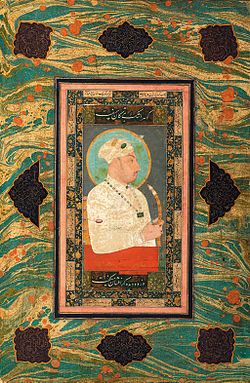
 12th Mughal Emperor of India
12th Mughal Emperor of IndiaReign 27 September 1719 - 26 April 1748
(28 years, 212 days)Coronation 29 September 1719 at Tajpur Predecessor Shah Jahan II Successor Ahmad Shah Bahadur Regent Syed Brothers (1719 - 1722) Spouse Badshah Begam Malika-uz-Zamani
Mahal Begum Malika-i-Jahan
Udhambai Kudsiya Begum
Safiya Sultan BegumIssue Shahriyar Shah Bahadur
Ahmad Shah Bahadur
Taj Muhammad
Anwer Ali
Badshah Begum
Jahan Afruz Banu Begum
Hazrat Begum Sahiba-uz-ZamaniFull name Roshan Akhtar Bahadur House Timurid Father Khujista Akhtar Jahan Shah Mother Qudsiya Begam Born 17 August 1702
Fatehpur, Mughal EmpireDied 26 April 1748 (aged 45)
Delhi, Mughal EmpireBurial Mausoleum of Muhammad Shah, Nizamuddin Awliya, Delhi Religion Islam Muhammad Shah (محمد شاه) (1748 – 1702) also known as Roshan Akhtar, was a Mughal emperor of India between 1719 and 1748.[1][2][3] He was son of Khujista Akhtar Jahan Shah, the fourth son of Bahadur Shah I. Ascending the throne at 17 with the help of the Sayyid Brothers, he later got rid of them with the help of Nizam-ul-Mulk Chin Qilich Khan. Historians nicknamed him Rangeela, meaning "joy-maker".[4]
Contents
Origins and youth
Roshan Akhtar was born in 1702 at Fatehpur Sikri to prince Khujista Akhtar. Handsome and quick to learn, his mother took good care of his education, while his father enhanced his administrative abilities. During the war of Succession his father was killed, and the 12-year-old prince and his mother were imprisoned but spared from death. In 1719 many Mughal emperors briefly ascended to the throne, but the Sayyid Brothers eventually chose young Roshan Akhtar as Emperor.
Succession and early reign
On 29 September 1719, Prince Roshan Akhtar was given the title Abu Al-Fatah Naseer-ud-Din Roshan Akhtar Muhammad Shah and enthroned in the Red Fort. His mother was given an allowance of 15 thousand rupees monthly for her needs, but the Sayyid brothers kept the new emperor under strict supervision. Chafing at this control — and learning that the Nizam-ul-Mulk was also angry with them — in 1722 the emperor ordered Muhammad Ameen Khan Turani, Mir Muhammad Ameen Irani and Muhammad Haider Beg to kill the Sayyid Brothers. Previously the emperor had to fight Muhammad Ibrahim, but Muhammad Shah defeated him on 13 November 1720.
Personal reign
After Muhammad Shah got rid of the Sayyid Brothers, he appointed the Nizam-ul-Mulk as Grand Vizier on 21 February 1722. He advised the new Mughal Emperor Muhammad Shah to be "as cautious as Akbar and as brave as Aurangzeb". He also advised him to help Shah Tahmasp II of Persia; since Shah Tahmasp I had helped Humayun in his time of need. When all these advices turned to no avail, the Nizam-ul-Mulk left Delhi and went to Deccan in 1723.
At the same time, the governorship of Deccan was given to Mubaraz Khan, who constantly fought with the Marathas. Taking advantage of it, the Nizam-ul-Mulk allied with the Marathas and defeated Mubaraz Khan. Thus, though he lost the posts of Grand Vizier, governor of Malwa and Gujrat, he became an independent ruler of the newly created state of Hyderabad in 1725.
During this time the Maratha War (1723–1737) began and it became a solely destructive war for the Mughals. Furthermore, in 1724 Oudh became independent under Nawab Saadat Ali Khan. All over the empire there was chaos and destruction. In Punjab region the Sikhs were at war with the Mughals. In Ajmer, Rana Ajeet Singh was the de facto ruler and allied himself with the Marathas. While in Deccan the Marathas had proclaimed independence and were already on the warpath. All this greatly contributed to the decline of the Mughal Empire.
Despite all the problems occurring during his reign, Muhammad Shah was somewhat the last able ruler the empire ever had. He in fact, protected the empire for so long, and stopped it from falling completely during his reign. His removing of his three hated ministers, namely Koki Jee, Roshan-ud-Daula and Shah Abdul Ghafur, is a proof of his administrative capabilities. During his reign, he sent an ambassador to the Ottoman Sultan Mahmud I advising it to continue to halt Persian military expansion.
Cultural advancements
Urdu language had already been invented before Muhammad Shah's reign. However, during his reign it became a common language among the people and the Emperor installed it as Court language.But many writers say it was British who made Urdu the Official Language and that Urdu was never court language during Mughal Rule. Hindi became common among the masses. Shah Waliullah was born in Delhi. When the strength of his students increased, the Emperor built a Madrasah for them. During his reign, the Quran was translated for the first time in Persian. Also, during his reign, the formal Tartar dress, normally worn by the high Mughal nobility, was replaced by the Sherwani.
It is said that Mohammad shah promoted arts like Dance and Music with great passion and almost at the cost of administrative priorities paving the way for the disintegration of governance.
Maratha War
After Nizam-ul-Mulk left Delhi, the Marathas had already expanded up to river Narmada.Therefore early in 1723 they invaded the rich province of Malwa. The Mughal Emperor entrusted its defence to its governor, who failed him. Thus by winter of the same year, they reached Ujjain, the capital of Malwa.
In 1725, the governorship of Gujarat was transferred to Sarbuland Khan. Enraged by the authority of the Mughal Emperor Muhammad Shah the Marathas invaded Gujarat but were routed by Sarbuland Khan and his forces. This was mainly because most of the Maratha forces, including their leader Baji Rao I, were at the time fighting the Nizam-ul-Mulk in Hyderabad.
The war with Hyderabad, however, proceeded favourably for the Marathas. In 1728, during February, the Nizam was decisively defeated at the Battle of Palkhed. Although the Nizam had managed to add Traimbek Rao, Dhabedi and Sanbhoji to his side, they were all defeated in 1731 at the Battle of Bhelapur. Thus the Nizam's plot was revealed. However, Baji Rao wanted peace in the south so that he could expand in the north. A treaty was signed between the two in which both agreed to help each other. The Nizam could expand to the south while Baji Rao could expand in the north. With peace secured, Baji Rao attacked Gujarat with full force and finally drove out Sarbuland Khan by 1735.
During this course, the Mughal forces were badly defeated at Ahmedabad in 1731. In 1736, the Marathas sent an ultimatum to Delhi and demanded the Emperor to give up Mathura. The demand being evaded, he invaded Mathura but was defeated by Imperial forces under Saadat Ali Khan. At this time, it may be noticed that the Jats under Suraj Mal seized a sizable portion of Agra and Mathura districts. The Emperor now asked the Nizam-ul-Mulk for help, who immediately broke the treaty with the Marathas on behalf of the Mughal Emperor. Both forces fought the Marathas at Bhopal in 1737 but were defeated. The following year (1738), the Imperial forces were defeated at Agra and the Marathas now captured Agra and Mathura. At Ferozabad the Mughals lost yet another battle. The Emperor now set out himself against the Maratha leader Baji Rao but was still near Delhi when Baji Rao attacked and surrounded him at Delhi. The Imperial army was routed and Baji Rao entered Delhi. The Emperor became his puppet for several weeks.
According to the terms of the treaty signed by the two leaders, the Mughal Emperor gave Baji Rao 5 million rupees and made him the permanent governor of Malwa. The area between rivers Narmada and Chambal was given to the Marathas. Baji Rao returned the excess area back to the Mughal Emperor.
Invasion of Nadir Shah
In 1739, Nadir Shah invaded Delhi and looted it. It is an event of macro importance in Indian History as it resulted in the fall of the Mughal Empire.
Causes
Nadir Shah wanted to subdue Afghan rebels led by the Ghilzai tribe in the region around Kandahar.[5] He therefore requested the assistance of the Mughal Emperor Muhammad Shah to close the frontiers around Kabul and the Indus Valley so that the rebels may not flee or seek refuge. The Mughal Emperor Muhammad Shah gave a confirming reply to Nadir Shah but didn't do any thing practically, because the local Subedars and Faujdars sympathized with the Afghan and reject the reign of the Shea Persians. Outraged by this, Nadir Shah sent an ambassador to the Mughal Emperor Muhammad Shah. The Mughal Emperor did not provide a positive response and kept the Persians marginalized Delhi for an entire year. Thus Nadir Shah became furious with the Mughal Emperor Muhammad Shah, he knew that the Mughals had become weak and decided to capture the rich treasures of the Mughal Empire in Delhi and Agra.
Course of the war
On the basis of the above reasons, Nadir Shah invaded India and decided to attack from Afghanistan. In May, 1738 he attacked Northern Afghanistan. In the same month, he captured Ghazni, in June he captured Kabul and in September Jalalabad also fell to him. In November he surrounded the fortress of Peshawar and completely razed it to the ground. Finally in January 1739, he captured Lahore, the former capital of the Mughal Empire.
Now Nadir Shah had captured territory up to Attock and Muhammad Shah and his courtiers could not close their eyes from further danger. They finally understood that Persian Emperor was not the sort of enemy that could be bought off with the loot of a province. Furthermore he had devastated the area he just conquered. The cities of Wazirabad, Emanabad and Gujrat were not only sacked but razed to the ground, its population murdered.
In February 1739, Nadir Shah captured Sirhind and moved towards the field of Karnal, a battle destined to be fateful to the Mughal rulers. On 13 February, the battle of Karnal was fought. Emperor Muhammad Shah had over a hundred thousand force against Nadir Shah's 55,000 men but was still decisively defeated. In the event, the Khan Doran died and wrote a will that the Mughal and Afsharid emperors should not meet but Nadir Shah should be turned back from there at all costs. His will was disregarded and the Emperor himself met Nadir Shah in his camp and abdicated on 26 February, thirteen days after the Battle of Karnal. He handed over the keys of the Delhi gate and entered Delhi with him.
At first every thing was cordial among the two emperors. However rumours spread throughout Delhi that Nadir Shah was assassinated. The masses attacked the Persian force and slaughtered 900 Persian soldiers. At this Nadir Shah massacred the populace, and at least 30,000 people died. The Emperor, Nizam-ul-Mulk and Grand Vizier Nawab Qamar-id-Din Khan Bahadur went to Nadir Shah to plead for mercy and thus he stopped the massacre and turned into looting the Mughal treasury. The famous Peacock throne, the Darya-e-Noor diamond and unimaginable wealth was looted. In addition, elephants, horses and every thing that was liked was taken. Muhammad Shah had to marry his daughter Jahan Afruz Banu Begum to Nadir Shah's youngest son.
Now Muhammad Shah was crowned as emperor by Nadir Shah himself on 12 May, and Muhammad Shah ceded the area west of river Indus to Nadir Shah, although the Nawab of Sindh, Main Noor Mohammad Kalhoro continued to fight the Afsharids. Nadir Shah then looted the Koh-i-Noor diamond and other famous treasures. And later Nadir Shah and his Afsharid forces returned to Persia.
Results
After the Sayyid Brothers and the rebellious Marathas and Sikhs, this invasion destroyed what was left of the Mughal Empire and neared it to its end. The weakness of the Mughal army was clearly portrayed after this invasion. The Nawabs clearly could not even relieve their captured city of Delhi, which was the seat of their authority. The Mughals were completely looted of their wealth, and rebellions became commonplace. However, Nadir Shah's campaign against the Mughal Empire, caused the Ottoman Sultan Mahmud I to initiate the Otttoman-Persian War (1743-1746), in which the Mughal Emperor Muhammad Shah closely cooperated with the Ottomans and their ambassador Haji Yusuf Agha until his death in 1748.[5]
Later reign
After Nadir Shah's invasion, the Mughal Empire disintegrated rapidly. Nawab Alivardi Khan of Bengal proclaimed independence in 1740. In 1748, Ahmad Shah Abdali invaded India. Ahmad Shah Bahadur, Nawab Qamar-ud-Din and his son Mueen-ul-Mulk were sent with 75,000 men after the defeat of Shahnawaz Khan in Lahore. At the Battle of Sirhind, Ahmad Shah's 15,000 men were defeated and he was forced to retreat. There was a great rejoicing for this event in Delhi.
However, this victory was at a cost. The Grand Vizier Qamar-ud-Din had died at the battlefield. Initially this was kept a secret. However, when the news reached the Mughal Emperor, he could not speak, suddenly became sick and did not come out of his apartments for three days. During this course he fasted. His guards could hear him crying out loud and saying: "How could I bring about anyone as faithful as he Qamar-ud-Din". He died due to grief on 26 April 1748, his funeral was attended by visiting Imams from Mecca.[6]
Royal family
Emperor Muhammad Shah had four wives, but his most favourite was Badshah Begum, daughter of Emperor Farrukhsiyar. He married her on 8 December 1721 at Delhi, and gave her the title Nawab Malika-uz-Zamani (Queen of the Era). On this occasion there was a great ceremony lasting for weeks. She bore him his first son, Shahriyar Shah Bahadur, who died young on 19 July 1724. She was the most influential of all wives of the Emperor and exercised her opinions on him. Muhammad Shah married Mahal Begum on the same day as the first one and gave her the title Nawab Malika-i-Jahan (Queen of the World). She was also his most favourite. His third wife was Udhambai, also called Kudsiya Begum, who bore him his future successor, Ahmad Shah Bahadur on 23 December 1725. She was a formerly dancing girl and also a mansabdar of 50,000. He married his fourth wife Sufiya Sultan Begum later on. For some time during his early reign, her mother, Qudsiya Begum, also exercised power of the Empire. Muhammad Shah had three sons and three daughters, of which Badshah Begum died on 14 December 1724.
See also
References
- ^ Buyers, Christopher. "India, The Timurid Dynasty genealogy". The Royal Ark, Royal and Ruling Houses of Africa, Asia, Oceania and the Americas. http://www.royalark.net/India4/delhi11.htm. Retrieved 2009-06-12.
- ^ Rai, Raghunath (2006). History For Class 12: Cbse. Economics/vk India Enterprises. pp. 3. ISBN 8187139692.
- ^ Keene, H. G. (2004). The Fall of the Moghul Empire of Hindustan, Ch. III, 1719-48. Kessinger Publishing. ISBN 1419161849. Available here on Project Gutenberg.
- ^ "This eighteen-year-old prince went down into the history as Muhammad Shah, nicknamed Rangeela (or merrymaker). Traditionally historians describe him as licentious and lazy but there can be little doubt that he is one of the most underrated personalities in history." (Khurram Ali Shafique, "Muhammad Shah 'Rangeela' in Dawn - The Review, October 2000). Retrieved 2009-08-17.
- ^ a b Farooqi, Naimur Rahman (1989). Mughal-Ottoman relations: a study of political & diplomatic relations between Mughal India and the Ottoman Empire, 1556-1748. Idarah-i Adabiyat-i Delli. ASIN: B0006ETWB8. See Google Books search.
- ^ Farooqi, Naimur Rahman (1989). Mughal-Ottoman relations: a study of political & diplomatic relations between Mughal India and the Ottoman Empire, 1556-1748. Idarah-i Adabiyat-i Delli. ASIN: B0006ETWB8. See Google Books search.
Preceded by
Shah Jahan IIMughal Emperor
1719–1748Succeeded by
Ahmad Shah BahadurCategories:- Mughal emperors
- 1702 births
- 1748 deaths
Wikimedia Foundation. 2010.

